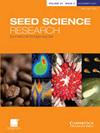韩国水鹿肠道传代后的种子回收率和发芽率
IF 1.9
3区 生物学
Q2 PLANT SCIENCES
引用次数: 2
摘要
大型食草动物可以通过内胆传播种子。韩国水鹿(Hydropotes inermis argyropus)是一种国际濒危物种,但在当地被认为是一种害虫,是一种潜在的内毒素种子传播媒介。本研究通过饲养试验,研究了韩国水鹿肠道摄食种子的传播效率、时间模式以及肠道摄食对种子恢复和发芽率的影响。包括从它的粪便中发芽的植物在内的8种植物被用来喂养3只韩国水鹿。当鹿消耗完所有提供的种子后,在24、48、72和96 h后收集其粪便,将收集到的粪便风干,每24 h(0-24、24 - 48、48 - 72和72 - 96 h)统计从粪便中取回的种子数量。在8种植物中,有6种种子完好无损。回收率最高的是白头草(33.7%),其次是山竹苋(24.5%)和藜草(14.4%)。大部分种子在24 ~ 48 h内恢复。对摄取和未摄取的四种种子进行了萌发试验,均有足够的回收率。肠道通道对种子萌发的影响因植物种类而异。通过肠道后发芽率显著下降。结果表明,韩国水鹿可以传播种子,尽管种子恢复和发芽率低,但代价很高。本文章由计算机程序翻译,如有差异,请以英文原文为准。
Seed recovery and germination rate after gut passage by Korean water deer (Hydropotes inermis argyropus)
Abstract Large herbivores can disperse seeds over long distances through endozoochory. The Korean water deer (Hydropotes inermis argyropus), an internationally vulnerable species but locally considered a vermin, is a potential endozoochorous seed dispersal vector. In this study, feeding experiments were conducted to test the efficiency of seed dispersal through gut ingestion by the Korean water deer, its temporal pattern and the effect of gut passage on seed recovery and germination rate. Eight plant species, including species that formerly germinated from its faeces, were used to feed three Korean water deer. Once the deer had consumed all the provided seeds, their faeces were collected after 24, 48, 72 and 96 h. The collected faeces were air-dried, and the number of seeds retrieved from the faeces was counted every 24 h (0–24, 24–48, 48–72 and 72–96 h). Among the eight plant species, six species were retrieved with intact seeds. Panicum bisulcatum had the highest recovery rate of 33.7%, followed by Amaranthus mangostanus (24.5%) and Chenopodium album (14.4%). Most of the seeds were recovered within the 24–48 h time interval. Germination tests were conducted on the ingested and uningested seeds for the four species which had a sufficient recovery rate. The effects of gut passage on seed germination differed according to plant species. The germination rate substantially decreased after gut passage. The results suggest that the Korean water deer can disperse seeds, potentially over long distances albeit at a high cost of low seed recovery and germination rate.
求助全文
通过发布文献求助,成功后即可免费获取论文全文。
去求助
来源期刊

Seed Science Research
生物-植物科学
CiteScore
3.60
自引率
4.80%
发文量
23
审稿时长
>12 weeks
期刊介绍:
Seed Science Research, the official journal of the International Society for Seed Science, is a leading international journal featuring high-quality original papers and review articles on the fundamental aspects of seed science, reviewed by internationally distinguished editors. The emphasis is on the physiology, biochemistry, molecular biology and ecology of seeds.
 求助内容:
求助内容: 应助结果提醒方式:
应助结果提醒方式:


